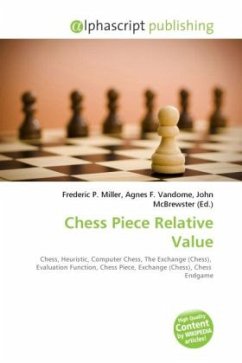
Chess Piece Relative Value
Versandkostenfrei!
Versandfertig in 6-10 Tagen
26,99 €
inkl. MwSt.

PAYBACK Punkte
13 °P sammeln!
In chess, the chess piece relative value system conventionally assigns a point value to each piece when assessing its relative strength in potentialexchanges. These values are used as a heuristic that helps determine how valuable a piece is strategically. They play no formal role in the game but are useful to players, and are also used in computer chess to help the computer evaluate positions. Calculations of the value of pieces provide only a rough idea of the state of play. The exact piece values will depend on the game situation, and can differ considerably from those given here. In some po...
In chess, the chess piece relative value system conventionally assigns a point value to each piece when assessing its relative strength in potentialexchanges. These values are used as a heuristic that helps determine how valuable a piece is strategically. They play no formal role in the game but are useful to players, and are also used in computer chess to help the computer evaluate positions. Calculations of the value of pieces provide only a rough idea of the state of play. The exact piece values will depend on the game situation, and can differ considerably from those given here. In some positions, a well-placed piece might be much more valuable than indicated by heuristics, while a badly-placed piece may be completely trapped and, thus, almost worthless. Valuations almost always assign the value 1 point to pawns (typically as the average value of a pawn in the starting position). Computer programs often represent the values of pieces and positions in terms of 'centipawns', where 100 centipawns = 1 pawn, which allows strategic features of the position, worth less than a single pawn, to be evaluated without requiring fractions.












